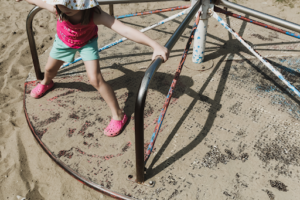
Retained primitive reflexes are immature movement patterns that can often have effects on a child’s overall development. Naturally, these reflexes should “integrate” or disappear during infancy. When a reflex is retained, more mature movement patterns are not developed, which can have an effect on sensory integration, posture, executive functioning skills, and overall neuroplasticity. Recognizing and treating these retained reflexes can have a big impact on a child’s overall development.
What are Primitive Reflexes?: A reflex is an automatic, unconscious response to stimuli. A reflex occurs within the brainstem, and therefore occurs without any conscious thought. The primitive reflexes are involuntary movement patterns that first emerge in utero. They stimulate the development of the sensory systems and promote developmental movement sequences. These reflexes typically “integrate” (replaced by more mature movement patterns) within the first year of childhood; however, in some cases, your child may experience reflex retention, meaning that the immature motor pattern is still in place. Retention of specific reflexes can affect your child’s posture, attention, sensory integration, executive functioning skills, sleep patterns, and even impulse control.
Some of the commonly retained primitive reflexes include:
- Moro Reflex
- Asymmetrical Tonic Neck Reflex (ATNR)
- Symmetrical Tonic Neck Reflex (STNR)
- Spinal Galant Reflex
What are the Signs of a Retained Reflex?
The signs of retained reflexes vary between the different reflexes. Some commonly retained reflexes and their symptoms are as follows?
- Moro Reflex:
- Vestibular sensitivities (e.g. dislike of rough and tumble play, dislike of swings, slides, and other playground equipment, having emotional outbursts due to sudden changes in head position or having feet off the floor).
- Unexpected, sudden changes in behavior
- Dislike of bright lights
- Sensitivity to loud sounds, difficulty filtering out background noise
- Need for control of situations
- Oversensitivity to textures/touch
- ATNR:
- Difficulty with movements that cross the body’s midline
- Difficulty with attention to task, poor focus, impulsivity
- Poor working memory
- Difficulty with throwing/catching a ball
- Difficulty with reading, writing and math skills
- Trouble with following a line, losing place while reading
- STNR:
- Poor sitting position, with the head lowering to the desk when working
- Heavy lean backwards in chair, legs wrapping around chair legs
- Fidgeting while seated, difficulty with concentration and attention
- Preferring to stand rather than sit while completing work
- Difficulty with impulse control
- Poor hand-eye coordination
- Weak muscles
- Spinal Galant Reflex:
- Difficulty with bladder control
- Dislike of tight fitting clothing, particularly around the waist
- Fidgety while sitting
- Difficulty with attention to task
- Poor balance/gross motor coordination
- Frequent bedwetting
How are Retained Reflexes Addressed?
Your child’s occupational therapist can assess your child for a suspected retained reflex. Once the therapist confirms the presence of the retained reflexes, the therapist will prescribe a home exercise program of isotonic and isometric exercises to help promote the integration of the reflex and use of more mature movement patterns. You child’s therapist may also provide ideas for play that move into and out of the movement patterns associated with retained reflexes.
Questions or Concerns?
If you have questions or concerns about your child’s reflexes, or suspect a retained reflex, please contact us at info@playworkschicago.com or 773-332-9439.
Natalie Machado, MS, OTR/L
Occupational Therapist
Reference:
http://suehyland.co.uk/ond/primitive-reflexes
Photo Credit: Ryan Bruce via burst.shopify.com
